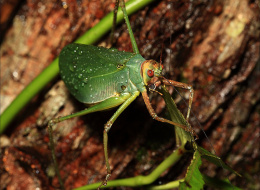Taxonomy usually refers to the theory and practice of describing, naming and classifying living things. Such work is essential for the fundamental understanding of biodiversity and its conservation. Yet the science behind delimiting the natural world into “species” is often neglected, misunderstood or even derided in some quarters. For example, refer to Goodreads and Todayinsci.
Whether we realise it or not, we are all inherent taxonomists. We classify things around us much in the same way as taxonomists distinguish between species; by assigning similar objects into recognisable groups. In the kitchen we separate our cutlery by knife, fork and spoon and wouldn’t dream of putting an onion or a potato in the fruit bowl. In fact our lives are filled with the need to separate and classify the many different objects that surround us.
It is the same with biodiversity. Most people concerned with biodiversity conservation commonly use the term “species” without a clear understanding of what separates one species from another, and why. This is where the science of taxonomy plays an integral role. Species are distinguished from each other in a number of ways. Although the definition of species has been the cause of significant historical debate, put simply, species are organisms usually recognized as morphologically distinct from other groups.
Despite the on-going biodiversity crisis, the number of new species described per scientist has not increased in the past 60-70 years. This is having a huge impact on conservation science. Many species will become extinct before they are described and we remain continually unaware of the total numbers of species that comprise global biodiversity. This is acknowledged by the Convention of Biodiversity and its signatories as a “taxonomic impediment”.
Even for groups of organisms that have considerable utilitarian value, there remain uncertain frameworks for classification. For example, the rattans of Africa, in common with their Asian relatives, form an integral part of subsistence strategies for many rural populations as well as providing the basis of a thriving urban-based industry, employing many thousands of people. However, the development of the rattan resource has, until recently, been hindered by a lack of basic knowledge of the exact species used, their ecological requirements and the socio-economic context of their utilisation.
A long-term study of the rattans of Africa has culminated in the publication of a taxonomic monograph of these climbing palms. Taxonomic work of this kind is not purely an academic exercise. In the case of African rattans, it is an essential basis for the conservation, development and management of the resource itself. It is important that the differences between species are clearly understood so that we know which species are of commercial importance and how they can be distinguished from other species that are not utilised and why. This knowledge is essential in order to undertake meaningful inventories of commercially important species and to be able to assess the potential of each species for cultivation and sustainable management. A structured taxonomic framework also ensures that any experimental or development work undertaken is replicable.
In short, taxonomy provides the basic foundations of conservation practice and sustainable management of the world remaining resources. It is perhaps time to better integrate the science of taxonomy back into the conservation world to meet the global biodiversity challenge that we currently face.
We want you to share Forests News content, which is licensed under Creative Commons Attribution-NonCommercial-ShareAlike 4.0 International (CC BY-NC-SA 4.0). This means you are free to redistribute our material for non-commercial purposes. All we ask is that you give Forests News appropriate credit and link to the original Forests News content, indicate if changes were made, and distribute your contributions under the same Creative Commons license. You must notify Forests News if you repost, reprint or reuse our materials by contacting forestsnews@cifor-icraf.org.
